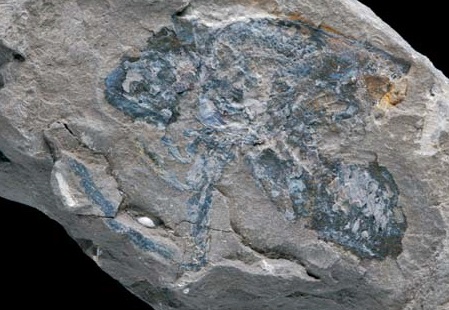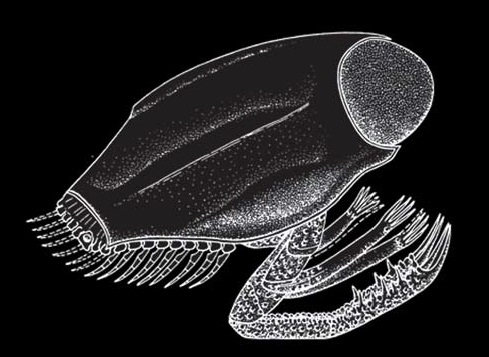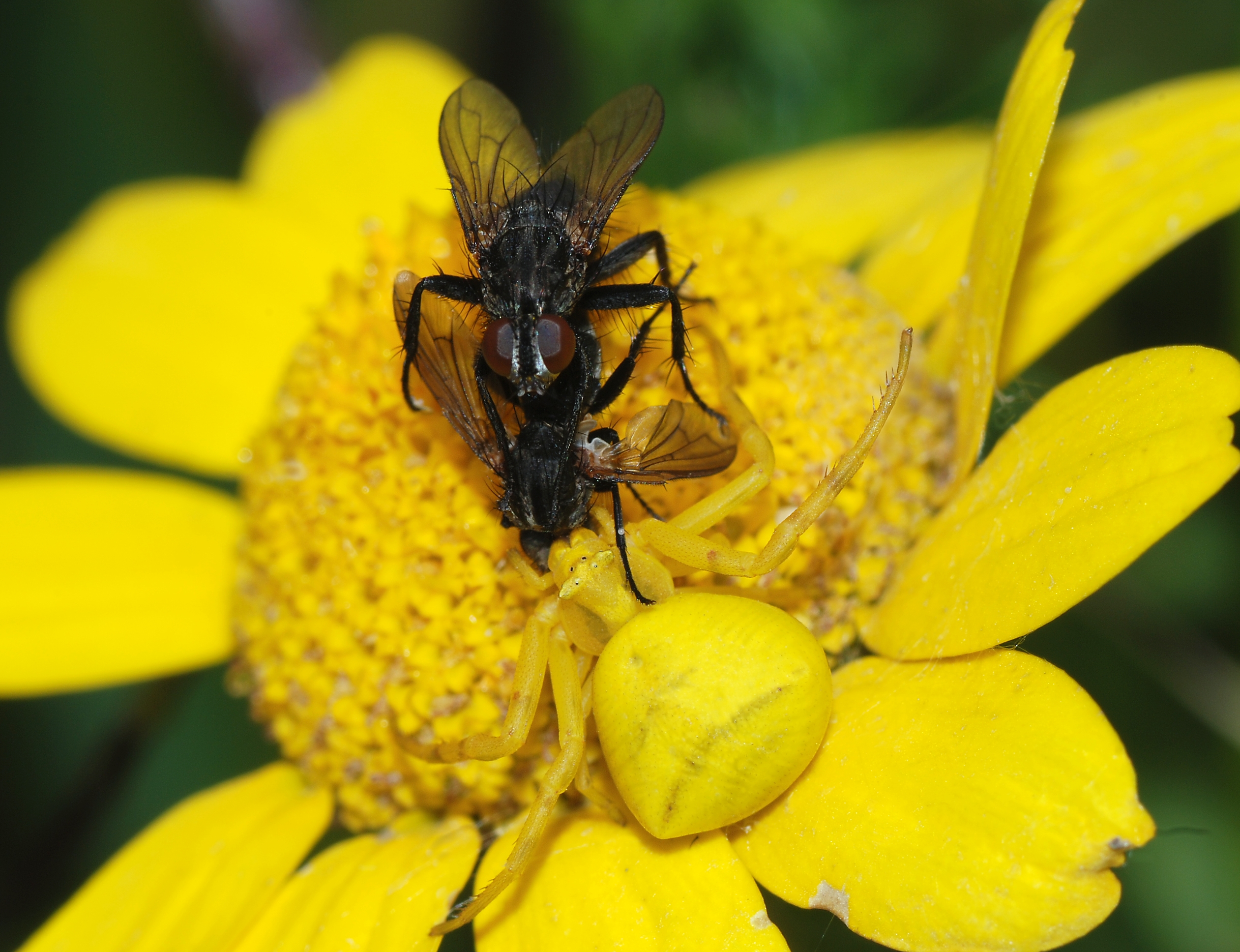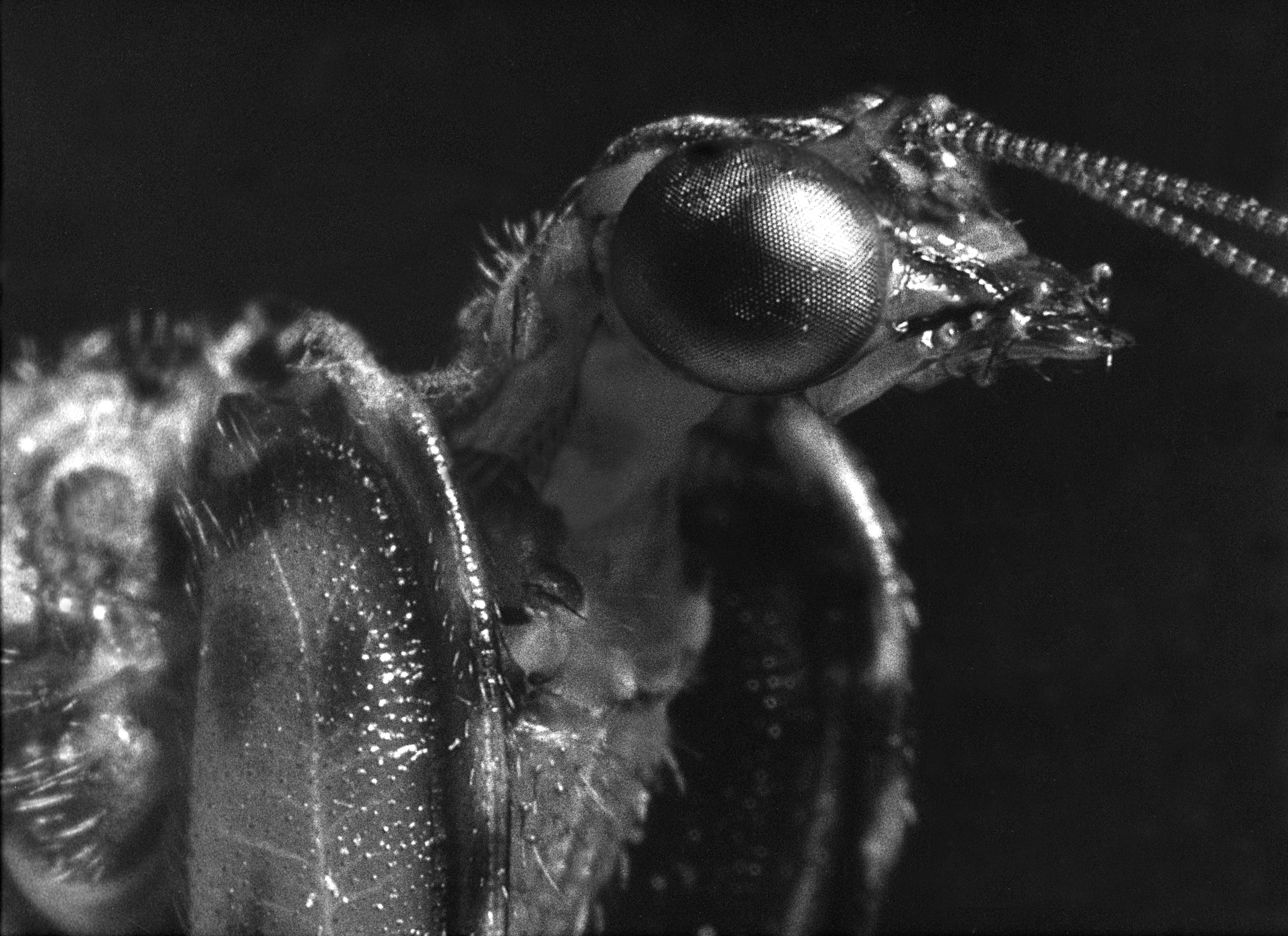|
Dollocaris
''Dollocaris'' is an extinct genus of thylacocephalan that lived during the Jurassic period. Fossils have been found in France, specifically the La Voulte-sur-Rhône lagerstätte. It is known for its massive compound eyes, giving ''Dollocaris'' a rather characteristic appearance. One species is currently known, ''D. ingens''. Description Adult specimens of ''Dollocaris'' measured over in length. It sported a row of small appendages to assist in swimming, as well as three pairs of clawed segmented legs, but it was probably a poor swimmer, instead depending on ambush to hunt prey. It is known for its well-preserved, large compound eyes A compound eye is a visual organ found in arthropods such as insects and crustaceans. It may consist of thousands of ommatidia, which are tiny independent photoreception units that consist of a cornea, lens, and photoreceptor cells which distin ..., sporting well-preserved individual retinula cells, which assisted in catching prey. References ... [...More Info...] [...Related Items...] OR: [Wikipedia] [Google] [Baidu] |
Thylacocephala
The Thylacocephala (from the Greek or ', meaning " pouch", and or ' meaning "head") are a unique grouping of extinct probable mandibulate arthropods, that have been considered by some researchers as having possible crustacean affinities. As a class they have a short research history, having been erected in the early 1980s. They typically possess a large, laterally flattened carapace that encompasses the entire body. The compound eyes tend to be large and bulbous, and occupy a frontal notch on the carapace. They possess three pairs of large raptorial limbs, and the abdomen bears a battery of small swimming limbs. Inconclusive claims of thylacocephalans have been reported from the lower lower Cambrian ('' Zhenghecaris''), but later study considered that genus as radiodont or arthropod with uncertain systematic position. The oldest unequivocal fossils are Upper Ordovician and Lower Silurian in age. As a group, the Thylacocephala survived to the Santonian stage of the Upper C ... [...More Info...] [...Related Items...] OR: [Wikipedia] [Google] [Baidu] |
Concavicarida
The Thylacocephala (from the Greek or ', meaning " pouch", and or ' meaning "head") are a unique grouping of extinct probable mandibulate arthropods, that have been considered by some researchers as having possible crustacean affinities. As a class they have a short research history, having been erected in the early 1980s. They typically possess a large, laterally flattened carapace that encompasses the entire body. The compound eyes tend to be large and bulbous, and occupy a frontal notch on the carapace. They possess three pairs of large raptorial limbs, and the abdomen bears a battery of small swimming limbs. Inconclusive claims of thylacocephalans have been reported from the lower lower Cambrian ('' Zhenghecaris''), but later study considered that genus as radiodont or arthropod with uncertain systematic position. The oldest unequivocal fossils are Upper Ordovician and Lower Silurian in age. As a group, the Thylacocephala survived to the Santonian stage of the Uppe ... [...More Info...] [...Related Items...] OR: [Wikipedia] [Google] [Baidu] |
Thylacocephala
The Thylacocephala (from the Greek or ', meaning " pouch", and or ' meaning "head") are a unique grouping of extinct probable mandibulate arthropods, that have been considered by some researchers as having possible crustacean affinities. As a class they have a short research history, having been erected in the early 1980s. They typically possess a large, laterally flattened carapace that encompasses the entire body. The compound eyes tend to be large and bulbous, and occupy a frontal notch on the carapace. They possess three pairs of large raptorial limbs, and the abdomen bears a battery of small swimming limbs. Inconclusive claims of thylacocephalans have been reported from the lower lower Cambrian ('' Zhenghecaris''), but later study considered that genus as radiodont or arthropod with uncertain systematic position. The oldest unequivocal fossils are Upper Ordovician and Lower Silurian in age. As a group, the Thylacocephala survived to the Santonian stage of the Upper C ... [...More Info...] [...Related Items...] OR: [Wikipedia] [Google] [Baidu] |
Animalia
Animals are multicellular, eukaryotic organisms in the biological kingdom Animalia. With few exceptions, animals consume organic material, breathe oxygen, are able to move, can reproduce sexually, and go through an ontogenetic stage in which their body consists of a hollow sphere of cells, the blastula, during embryonic development. Over 1.5 million living animal species have been described—of which around 1 million are insects—but it has been estimated there are over 7 million animal species in total. Animals range in length from to . They have complex interactions with each other and their environments, forming intricate food webs. The scientific study of animals is known as zoology. Most living animal species are in Bilateria, a clade whose members have a Symmetry in biology#Bilateral symmetry, bilaterally symmetric body plan. The Bilateria include the protostomes, containing animals such as nematodes, arthropods, flatworms, annelids and molluscs, and th ... [...More Info...] [...Related Items...] OR: [Wikipedia] [Google] [Baidu] |
Ambush Predator
Ambush predators or sit-and-wait predators are carnivorous animals that capture or trap prey via stealth, luring or by (typically instinctive) strategies utilizing an element of surprise. Unlike pursuit predators, who chase to capture prey using sheer speed or endurance, ambush predators avoid fatigue by staying in concealment, waiting patiently for the prey to get near, before launching a sudden overwhelming attack that quickly incapacitates and captures the prey. The ambush is often opportunistic, and may be set by hiding in a burrow, by camouflage, by aggressive mimicry, or by the use of a trap (e.g. a web). The predator then uses a combination of senses to detect and assess the prey, and to time the strike. Nocturnal ambush predators such as cats and snakes have vertical slit pupils helping them to judge the distance to prey in dim light. Different ambush predators use a variety of means to capture their prey, from the long sticky tongues of chameleons to the expandi ... [...More Info...] [...Related Items...] OR: [Wikipedia] [Google] [Baidu] |
Jurassic Crustaceans
The Jurassic ( ) is a geologic period and stratigraphic system that spanned from the end of the Triassic Period million years ago (Mya) to the beginning of the Cretaceous Period, approximately Mya. The Jurassic constitutes the middle period of the Mesozoic Era and is named after the Jura Mountains, where limestone strata from the period were first identified. The start of the Jurassic was marked by the major Triassic–Jurassic extinction event, associated with the eruption of the Central Atlantic Magmatic Province. The beginning of the Toarcian Stage started around 183 million years ago and is marked by an extinction event associated with widespread oceanic anoxia, ocean acidification, and elevated temperatures likely caused by the eruption of the Karoo-Ferrar large igneous provinces. The end of the Jurassic, however, has no clear boundary with the Cretaceous and is the only boundary between geological periods to remain formally undefined. By the beginning of the Jura ... [...More Info...] [...Related Items...] OR: [Wikipedia] [Google] [Baidu] |
Prehistoric Crustacean Genera
Prehistory, also known as pre-literary history, is the period of human history between the use of the first stone tools by hominins 3.3 million years ago and the beginning of recorded history with the invention of writing systems. The use of symbols, marks, and images appears very early among humans, but the earliest known writing systems appeared 5000 years ago. It took thousands of years for writing systems to be widely adopted, with writing spreading to almost all cultures by the 19th century. The end of prehistory therefore came at very different times in different places, and the term is less often used in discussing societies where prehistory ended relatively recently. In the early Bronze Age, Sumer in Mesopotamia, the Indus Valley Civilisation, and ancient Egypt were the first civilizations to develop their own scripts and to keep historical records, with their neighbors following. Most other civilizations reached the end of prehistory during the following Iron Age. ... [...More Info...] [...Related Items...] OR: [Wikipedia] [Google] [Baidu] |
Compound Eyes
A compound eye is a visual organ found in arthropods such as insects and crustaceans. It may consist of thousands of ommatidia, which are tiny independent photoreception units that consist of a cornea, lens, and photoreceptor cells which distinguish brightness and color. The image perceived by this arthropod eye is a combination of inputs from the numerous ommatidia, which are oriented to point in slightly different directions. Compared with single-aperture eyes, compound eyes have poor image resolution; however, they possess a very large view angle and the ability to detect fast movement and, in some cases, the polarization of light. Because a compound eye is made up of a collection of ommatidia, each with its own lens, light will enter each ommatidium instead of using a single entrance point. The individual light receptors behind each lens are then turned on and off due to a series of changes in the light intensity during movement or when an object in moving, creating a flicke ... [...More Info...] [...Related Items...] OR: [Wikipedia] [Google] [Baidu] |
France
France (), officially the French Republic ( ), is a country primarily located in Western Europe. It also comprises of overseas regions and territories in the Americas and the Atlantic, Pacific and Indian Oceans. Its metropolitan area extends from the Rhine to the Atlantic Ocean and from the Mediterranean Sea to the English Channel and the North Sea; overseas territories include French Guiana in South America, Saint Pierre and Miquelon in the North Atlantic, the French West Indies, and many islands in Oceania and the Indian Ocean. Due to its several coastal territories, France has the largest exclusive economic zone in the world. France borders Belgium, Luxembourg, Germany, Switzerland, Monaco, Italy, Andorra, and Spain in continental Europe, as well as the Netherlands, Suriname, and Brazil in the Americas via its overseas territories in French Guiana and Saint Martin. Its eighteen integral regions (five of which are overseas) span a combined area of ... [...More Info...] [...Related Items...] OR: [Wikipedia] [Google] [Baidu] |
Lagerstätte
A Lagerstätte (, from ''Lager'' 'storage, lair' '' Stätte'' 'place'; plural ''Lagerstätten'') is a sedimentary deposit that exhibits extraordinary fossils with exceptional preservation—sometimes including preserved soft tissues. These formations may have resulted from carcass burial in an anoxic environment with minimal bacteria, thus delaying the decomposition of both gross and fine biological features until long after a durable impression was created in the surrounding matrix. ''Lagerstätten'' span geological time from the Neoproterozoic era to the present. Worldwide, some of the best examples of near-perfect fossilization are the Cambrian Maotianshan shales and Burgess Shale, the Silurian Waukesha Biota, the Devonian Hunsrück Slates and Gogo Formation, the Carboniferous Mazon Creek, the Jurassic Posidonia Shale and Solnhofen Limestone, the Cretaceous Yixian, Santana, and Agua Nueva formations, the Eocene Green River Formation, the Miocene Foulden Maar and ... [...More Info...] [...Related Items...] OR: [Wikipedia] [Google] [Baidu] |
La Voulte-sur-Rhône (lagerstätte)
The late Middle Jurassic lagerstätte at La Voulte-sur-Rhône, in the Ardèche region of southwestern France, offers paleontologists an outstanding view of an undisturbed paleoecosystem that was preserved in fine detail as organisms died at the site and settled to the bottom of a shallow epicontinental sea, with a folded floor that in places exceeded 200 m at this site. The site preserves a marine system of the Lower Callovian stage, a little over 160 mya. The sequence is exposed in a series of quarries at La Boissine, west of the village of La Voulte-sur-Rhône. Iron pyrites in the silty shale are symptoms of an anoxic environment. The site was recognized among French paleontologists from the mid-nineteenth century for its finely detailed fossils. Preservation Some soft parts of organisms are preserved as phosphatised concretions, in exceptional cases down to cellular details, ''e.g.'' retinal structures in the eyes of conchyliocarid crustacea. Apart from Beecher's Tr ... [...More Info...] [...Related Items...] OR: [Wikipedia] [Google] [Baidu] |







